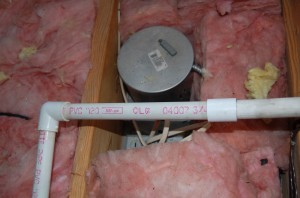 I need to tell you about the first house I renovated. Years ago my husband and I purchased a very old cottage on the water. The view was great, but the house was horrible in many ways. We moved in and immediately started removing walls and rearranging the interior to meet our growing families needs.
I need to tell you about the first house I renovated. Years ago my husband and I purchased a very old cottage on the water. The view was great, but the house was horrible in many ways. We moved in and immediately started removing walls and rearranging the interior to meet our growing families needs.
Since the house was a slab on grade, it was only a matter of time before our poking into the structure of the house revealed termites. Having seen recessed lighting in all the architectural magazines, decided we needed recessed lighting in our newly renovated great room/kitchen/dining room of our house.
Being in the construction business, we had a lot of requests for recessed lights and decided to install a similar number of lights, on dimmers of course, in our new space. We spent a small fortune on recessed lights. After the rooms were completed, the recessed lights looked wonderful equidistantly spaced around the perimeter of the twin inverted tray ceilings. Just gorgeous. Then we turned them on. We had created a tarmac! It was way too much light, and didn’t perform at all as we had expected, they seemed to allow in too much heat. We ended up using the ceiling fan in the middle and never turning them on and wishing we had left them out of the design completely.
We made the mistake of doing what everyone else was doing without doing the research to determine if recessed lights were even right for our application. Thankfully that house was short lived, Hurricane Isabell saw to that; however I will never forget the lesson.
Whether it is for a new home or your existing home, consider these points before you choose to go the recessed route. Recessed lights are metal boxes that contain a light source that fit in that space above your drywall. If there is insulation above your drywall, then you have a cold metal box that conducts hot and cold immensely well in lieu of insulation on your ceiling. This is where I need to remind you that your mom always told you to wear a hat because you lose almost all your heat through your head. You mother was a genius, that’s why insulation requirements are always greater for ceilings than for walls. This is not a good place to reduce insulation for any reason.
There are a few manufacturers who have begun making sealed recessed lighting to reduce the amount of air that flows through these types of lights. Unless yours were purchased in the last couple of years and specifically state on them that they are sealed units, they are not. Consider them small chimneys with their flues wide open pumping your conditioned air right into your attic.
I did an audit last week on a beautiful house with 8 recessed lights in the kitchen. The homeowner kept saying that this was one of the hottest rooms in the house and they figured it must be the old windows. After installing my blower door in the front door of the house and turning it on I went immediately to the kitchen. Standing under one of the recessed lights was like standing under a blow dryer. Hot moist air from the attic was flowing down with nothing to stop it. The homeowner was shocked.
Remember that your house has a barrier between the conditioned air inside and the rest of the world called a building envelope. Recessed lights are holes in that envelope. Think of it like a bucket filled with water, even a little hole will eventually empty the bucket entirely of its contents given enough time. If you absolutely must have recessed lights or have them and want to keep them, only install sealed units. Only install them in areas where you will not be displacing insulation to do it. And most importantly, make sure that there is either a CFL or an LED bulb in it and nothing else.
Got recessed lights? Curious how they are performing? Want to know just how much money they are costing you? Drop me an email e.guinn@DanGuinnHomes.com or give me a call 804 695 2578. Let’s see how many hair dryers you have installed in your house.
